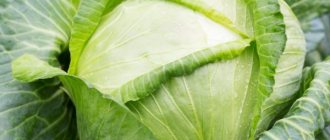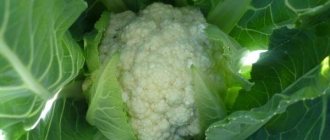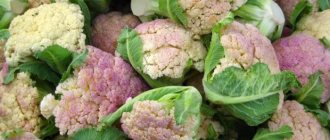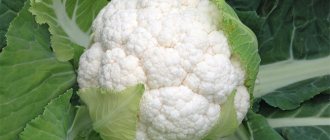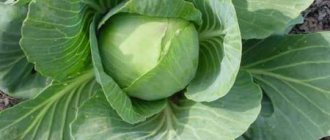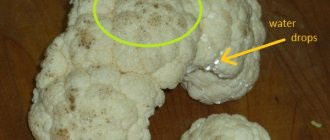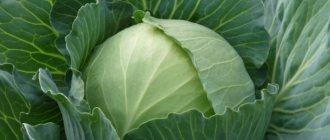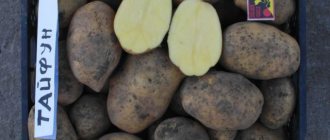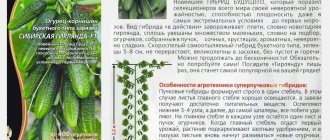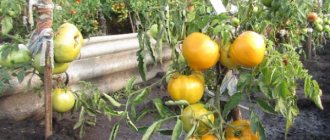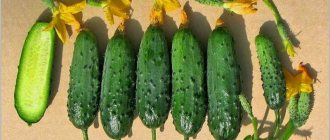Reviews of cauliflower Snowball 123 are mostly positive. Gardeners praise the crop for its good taste, juiciness, rapid ripening and frost resistance. Cauliflower has long been considered one of the favorite vegetables of gardeners and cooks, which allows you to prepare many healthy and tasty dishes.
Eating cauliflower has a positive effect on the human body
Description of Cauliflower Snowball
From the photo of cauliflower “Snowball 123” you can determine that its heads are dense, snow-white in color, and resemble a ball in appearance (hence the name). The variety appeared relatively recently, in 1994. It was developed by French specialists from the HM company. CLAUSE SA "Snowball 123" can be grown in any region. It takes root well in the middle zone and is very popular among summer residents.
Cabbage ripens 90 days after sowing. The seeds sprout abundantly. A crop with dense round heads, weighing 500-1000 g. The cabbage rosette is erect, compact, the leaves are tall, covering the head of cabbage from sunlight, so its color remains snow-white until fully ripe.
Comment! The size of the heads of Snowball 123 cauliflower depends on the growing climate and compliance with the rules of agricultural technology.
Description of the fruit
The head of this cabbage is round, slightly flattened. Dense, strong, elastic, lumpy, it is pleasant to hold it in your hands and contemplate its whiteness with pleasure. Heads of cabbage almost never have blemishes on their surface.
Due to the growth characteristics, there is no need to break the top leaves to cover the head of cabbage. The variety takes care of itself carefully. With its small upper leaves it covers its head of cabbage, thus protecting it from external influences.
The size of the average fruit reaches 1000 g, but specimens weighing 2 kg are not uncommon.
Advantages and disadvantages
Cabbage "Snowball 123" has a number of advantages. These include:
- Resistance to such well-known diseases as blackleg, clubroot, and downy mildew.
- Simultaneous ripening on almost all plants.
- Resistance to temperature changes (withstands frost down to -4 ° C).
- Does not require additional shelter due to tall leaves.
- Has excellent taste characteristics.
- Widely used in cooking.
The disadvantages of the culture include poor preservation of heads of cabbage in the garden. Ripe cabbage heads must be harvested on time.
Description of the variety
Vegetable growers appreciated the mid-early variety for its excellent taste and commercial qualities.
Cabbage of this variety is suitable for all culinary treatments. Boiled, fried, pickled, it retains its consistency, remains dense and elastic. The texture of cabbage inflorescences is not lost and this allows it to be processed using any culinary imagination.
Stability of yield is one of the main indicators for cabbage of this variety. Once grown in their gardens and fields, farmers and amateur vegetable growers are convinced that the variety deserves their attention.
Snowball Cauliflower Yield
The variety is characterized by high productivity. For this reason, it is in great demand among domestic gardeners, and in Europe, Snowball 123 cauliflower is grown in huge plantations. With proper care, approximately 4 kg of vegetables can be harvested from one square meter of land. The weight of the fork can reach 1.5 kg.
Mature cabbage heads require immediate harvest
Harvesting and storage
When sowing seeds at the end of February, harvesting occurs in early July. Ripe heads cannot be left on the bushes, otherwise they will lose quality - they will become loose and yellow, and their taste will deteriorate. Every two days, gardeners are advised to inspect the beds and cut off inflorescences ready for harvesting.
A sharp knife is used for cutting. The heads are removed along with several leaves and immediately put in a cool place. If long-term storage is necessary, Snowball cabbage is dug up along with the root and sent to the cellar, hanging head down. Recommended conditions for storing cauliflower are temperature in the range of +1...+4 degrees, humidity at 95%. Before storing vegetables, the cellar is treated with a solution of copper sulfate.
Attention! The main condition for long-term storage of heads is the absence of light. Cabbage inflorescences store well in the refrigerator if you wrap them in cling film.
The cauliflower variety Snowball has many fans both in Europe and the CIS countries. It captivated vegetable growers with its high yield and excellent taste characteristics. In order for the crop to please you with a rich harvest, you will have to follow the rules of agricultural technology and provide the cabbage with ideal conditions for development. The efforts spent will certainly pay off - an attentive vegetable grower will be rewarded with dense, beautiful, tasty inflorescences.
Planting and caring for cabbage Snowball 123
Most often, cauliflower variety "Snowball 123" is grown through seedlings. Seeds are usually sown at home. If you adhere to the laws of agricultural technology, the result will be 100% guaranteed.
To obtain good seedlings, cauliflower must be sown in late February - early March, observing the required stages of the planting process:
- seed treatment;
- soil preparation;
- proper care.
The procedure for preparing planting material does not take much time. For quick germination, it is advisable to soak the Snowball 123 cauliflower seeds in warm water (50 °C) for half an hour before planting and then dry them.
It is better to use soil for the crop purchased from specialized garden stores, but you can also use soil from your garden plot. In the latter case, it is advisable to mix it in equal parts with peat and humus, and also sterilize it. This can be done in the oven at 80 degrees for half an hour.
Important! To prevent the soil from becoming infertile, you should not allow the temperature in the oven to rise.
To germinate Snowball 123 seedlings, different containers are used, the main thing is that their depth is at least 10 cm. Peat cups are considered the best place for the growth of young shoots.
Seeds are sown in moist soil to a depth of 1-1.5 cm, at a distance of 3-4 cm from each other. To avoid subsequent picking of seedlings, you can plant each seed in a separate pot.
Since cabbage is a light-loving crop, and in early spring the daylight hours are short, the seedlings need to be provided with additional lighting.
Young shoots are watered once a week. It is advisable to use a spray bottle for the procedure. A couple of times during the process of growing seedlings, complex fertilizer is added to the water.
To increase the stability of cauliflower, it should be hilled regularly.
Plants are picked when a pair of strong leaves appear on the surface of the stems. Each sprout is transplanted into a larger glass. It is better to carry out the procedure when the sprouts are 12 days old.
Seedlings are planted in beds that are well warmed up and illuminated by the sun, in an area where cabbage, radishes, radishes and other cruciferous crops have not grown before. The soil for planting cabbage seedlings should be neutral. In autumn, lime and organic fertilizers must be added to acidic soil. It is customary to plant “Snowball 123” in May. Seedlings are placed according to a pattern of 0.3 by 0.7 meters.
Attention! The sprouts need to be planted up to the first leaf to a depth of about 20 cm.
Diseases and pests
The vegetable can suffer from the same pests as white cabbage. Downy mildew, fusarium, rot, as well as aphids, slugs, cutworms and cruciferous flea beetles can cause damage to the crop. Insecticides or folk remedies will help in the fight against parasites.
For the treatment and prevention of diseases, “Snowball 123” is sprinkled or sprayed with an infusion of ash, tobacco, garlic, and can be treated with “Fitosporin”, “Entobacterin”, “Iskra” or “Aktara”. But judging by the reviews of gardeners, if you fight weeds in a timely manner, follow crop rotation and fertilizing regime, then troubles with growing cauliflower can be avoided.
Basic care
After planting the seedlings, make sure that the earthen ball is constantly in an optimally moist state. As soon as the soil dries out, nutrients stop flowing into the plant and this in turn affects the growth of vegetative mass, and then the yield.
It is unacceptable for planted seedlings to compete for nutrients with weeds. Weed control, the basis of productivity.
By following the conditions of agricultural technology for cultivating cabbage and obeying all the requirements of the cabbage plant, you can obtain an excellent harvest of highly marketable heads of cabbage without any special expenses.
Note
A week before planting cauliflower seedlings in open ground, they must be hardened off. To do this, cups with plants should be taken out to the veranda or balcony for several hours. And 3-4 days before planting, reduce watering and leave the seedlings outdoors.
The Snowball 123 variety is suitable for cultivation by direct sowing in the ground. The procedure can be performed as early as early May. 2-3 seeds are placed in the holes in the prepared beds, and at the moment when the sprouts reach the phase of two true leaves, weak specimens are plucked out.
If there is still a threat of frost in the region, it is necessary to install arcs over the cauliflower bed and secure the covering material on top: film, spunbond, lutrasil.
In order for the plants to be stable, they need to be hilled once a month.
Water the plants once a week
The crop is fed three times a season:
- After 20-30 days of growth in a permanent place, at the time of head formation.
- A month after the first feeding.
- 20 days before harvest.
The first feedings are made with mullein, chemical fertilizers containing boron, manganese and magnesium and boric acid. The last fertilization is carried out using the foliar method. Cabbage heads are sprayed with potassium sulfate in a proportion of 1 tbsp. l. substances into a bucket of water.
Comment! "Snowball 123" needs frequent moderate watering, especially on hot days.
Characteristics
Cabbage Sugarloaf
This variety does not require watering and can easily withstand temperature changes, so it is ideal for growing in climates with cold springs. Cabbage will easily survive March - April frosts and snowfall, when the air temperature drops to -4 degrees. But where it is colder in the spring, Snowball cabbage should be grown in a greenhouse.
Productivity
Snowball is a mid-season variety. From the moment the first shoots appear until harvest, a little more than 3 months should pass. With proper care, you can collect up to 4 kg of inflorescences from 1 square meter of land. The weight of one head ranges from 0.5 to 2 kg. If we compare this species with late-ripening varieties, it should be noted that their head weight of 2 kg is considered normal. Snowball cabbage weighs so much - this is rather an exception to the rule.
Plant parameters
The description of the variety states that mature inflorescences are tightly framed by leaves and reliably protected from harmful environmental influences. You can distinguish Snowball cabbage from other varieties by the following characteristics:
- The height of an adult plant is up to 70 cm, the diameter of the rosette is up to 60 cm;
- Fruit sizes - weight from 0.5 to 2 kg;
- Fruit color is white;
- Leaf dimensions - petioles 5 - 40 cm long;
- The color of the leaves is light green.
Cabbage Snowball
The size of an adult plant and fruit does not depend on weather conditions, but the yield depends on the intensity of watering and fertilizing. The characteristics of the variety indicate that the fruits retain their snow-white color for a long time and do not turn yellow over time. But the collected heads are poorly stored, so a large harvest should be preserved immediately.
Resistance to pests and diseases
The creators of the Snowball variety initially set themselves the task of creating a plant that has strong immunity to viral and bacterial infections. However, Snowball cabbage is quite often occupied by a dangerous pest - the cabbage fly.
The plant is also a “tidbit” for pests such as:
- Cabbage flea beetle;
- Cabbage aphid;
- Secretive proboscis;
- Scoop.
As a rule, these insects eat not only the leaves and inflorescences of the plant, but also weeds, so the main pest control activity is weeding. The fewer weeds, the fewer pests. This rule “works” one hundred percent.
Cabbage flea beetle
Also in hot weather, applying ash to the leaves, previously sprayed with water, helps a lot. Seedlings can be covered with dark or transparent film. When the harvest is completed, all tops should be burned. If you don’t burn it, but take it to the compost heap, the pests will continue to “roam” around the garden, and will return again next season.
